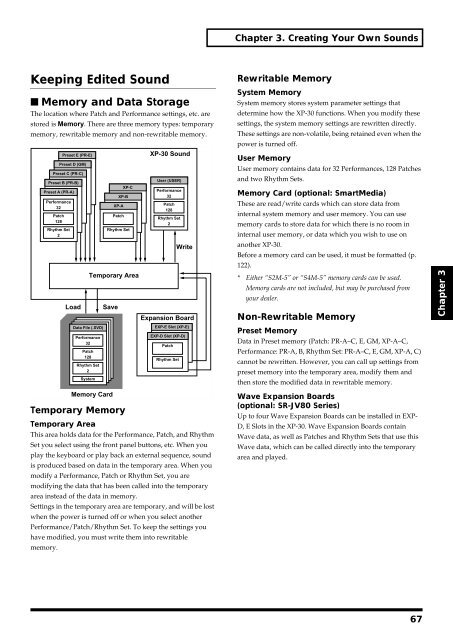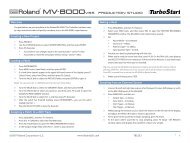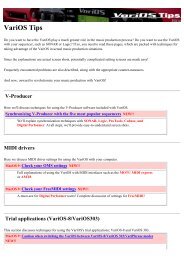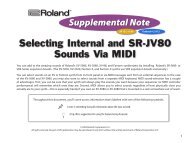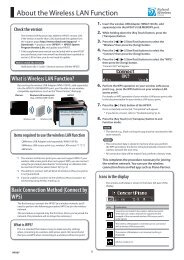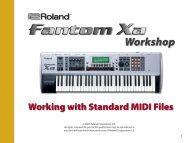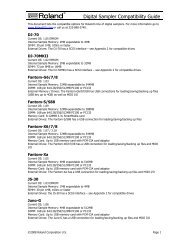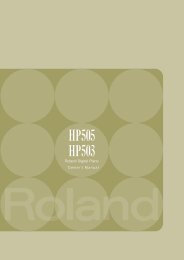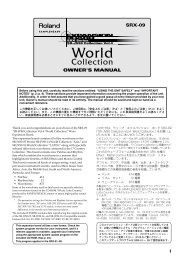You also want an ePaper? Increase the reach of your titles
YUMPU automatically turns print PDFs into web optimized ePapers that Google loves.
Chapter 3. Creating Your Own Sounds<br />
Keeping Edited Sound<br />
■ Memory and Data Storage<br />
The location where Patch and Performance settings, etc. are<br />
stored is Memory. There are three memory types: temporary<br />
memory, rewritable memory and non-rewritable memory.<br />
fig.3-19.e<br />
Preset E (PR-E)<br />
Preset D (GM)<br />
Preset C (PR-C)<br />
Preset B (PR-B)<br />
Preset A (PR-A)<br />
Performance<br />
32<br />
Patch<br />
128<br />
Rhythm Set<br />
2<br />
Load<br />
Data File (.SVD)<br />
Performance<br />
32<br />
Patch<br />
128<br />
Rhythm Set<br />
2<br />
System<br />
XP-C<br />
XP-B<br />
XP-A<br />
Patch<br />
Rhythm Set<br />
Temporary Area<br />
Save<br />
XP-30 Sound<br />
User (USER)<br />
Performance<br />
32<br />
Patch<br />
128<br />
Rhythm Set<br />
2<br />
EXP-E Slot (XP-E)<br />
EXP-D Slot (XP-D)<br />
Patch<br />
Rhythm Set<br />
Write<br />
Expansion Board<br />
Rewritable Memory<br />
System Memory<br />
System memory stores system parameter settings that<br />
determine how the XP-30 functions. When you modify these<br />
settings, the system memory settings are rewritten directly.<br />
These settings are non-volatile, being retained even when the<br />
power is turned off.<br />
User Memory<br />
User memory contains data for 32 Performances, 128 Patches<br />
and two Rhythm Sets.<br />
Memory Card (optional: SmartMedia)<br />
These are read/write cards which can store data from<br />
internal system memory and user memory. You can use<br />
memory cards to store data for which there is no room in<br />
internal user memory, or data which you wish to use on<br />
another XP-30.<br />
Before a memory card can be used, it must be formatted (p.<br />
122).<br />
* Either “S2M-5” or “S4M-5” memory cards can be used.<br />
Memory cards are not included, but may be purchased from<br />
your dealer.<br />
Non-Rewritable Memory<br />
Preset Memory<br />
Data in Preset memory (Patch: PR-A–C, E, GM, XP-A–C,<br />
Performance: PR-A, B, Rhythm Set: PR-A–C, E, GM, XP-A, C)<br />
cannot be rewritten. However, you can call up settings from<br />
preset memory into the temporary area, modify them and<br />
then store the modified data in rewritable memory.<br />
Chapter 3<br />
Memory Card<br />
Temporary Memory<br />
Temporary Area<br />
This area holds data for the Performance, Patch, and Rhythm<br />
Set you select using the front panel buttons, etc. When you<br />
play the keyboard or play back an external sequence, sound<br />
is produced based on data in the temporary area. When you<br />
modify a Performance, Patch or Rhythm Set, you are<br />
modifying the data that has been called into the temporary<br />
area instead of the data in memory.<br />
Settings in the temporary area are temporary, and will be lost<br />
when the power is turned off or when you select another<br />
Performance/Patch/Rhythm Set. To keep the settings you<br />
have modified, you must write them into rewritable<br />
memory.<br />
Wave Expansion Boards<br />
(optional: SR-JV80 Series)<br />
Up to four Wave Expansion Boards can be installed in EXP-<br />
D, E Slots in the XP-30. Wave Expansion Boards contain<br />
Wave data, as well as Patches and Rhythm Sets that use this<br />
Wave data, which can be called directly into the temporary<br />
area and played.<br />
67


